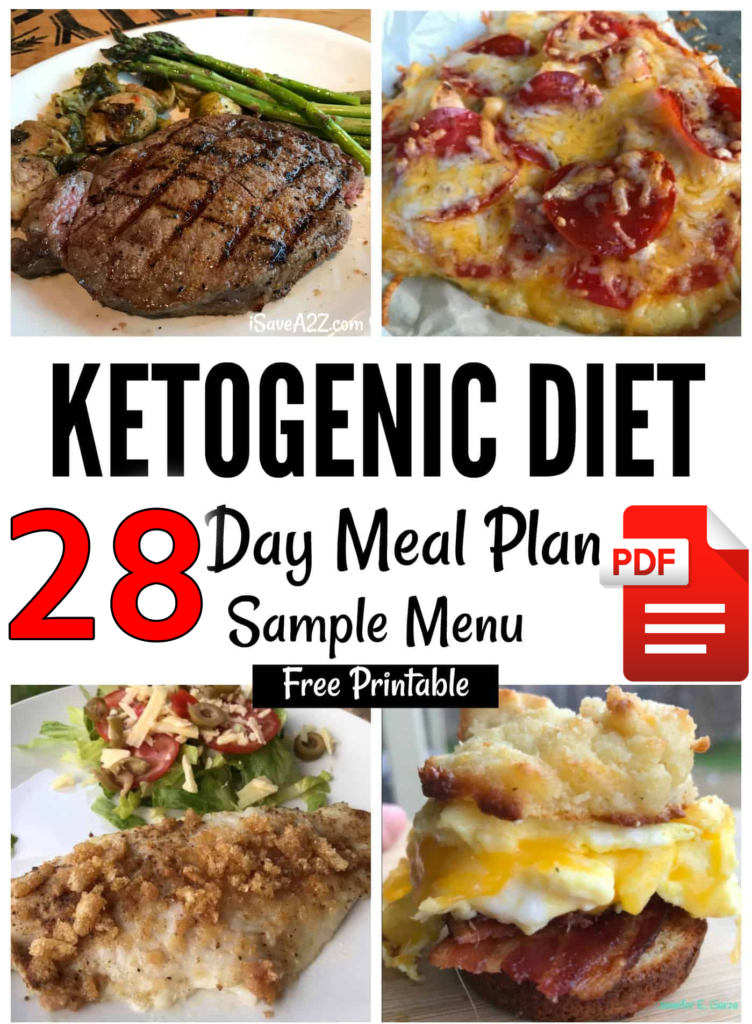Hey guys! So I know you’re all looking for something that’s easy to follow and I set out to make something that’s exactly that. A full one month meal plan of the ketogenic diet, the breakdown, the overview, and of course – the meals. Included are all recipes, all breakdowns of final macros, and the daily breakdown of what you should be eating.

Tips Before Starting
Some people don’t believe in counting calories on a ketogenic diet, but I am one of the few that does.
For most normal people, the amounts of fats and protein will be enough to naturally keep you satiated and naturally keep you in a calorie deficit. Though, the average American is not always normal. There’s tons of hormone, endocrine, and deficiency problems that we need to take into account.
That said, it doesn’t always allow you to lose weight when you are consuming more than your own body is expending.
“Macros” is a shortened version of macronutrients. These are the “big 3” – fats, proteins, and carbs. You can use a calculator to find out how much or how little of each you need in order to attain your goals. You can find the calculator on the navigation bar of the site!
A lot of people take their macros as a “set in stone” type of thing. You shouldn’t worry about hitting the mark every single day to the dot. If you’re a few calories over some days, a few calories under on others – it’s fine. Everything will even itself out in the end. It’s all about a long term plan that can work for you, and not the other way around.
I wanted to put it out there that I made this meal plan specifically with women in mind. I took an average of about 150 women and what their macros were. The end result was 1600 calories – broken down into 136g of fat, 74g of protein, and 20g net carbs a day. This is all built around a sedentary lifestyle, like most of us live. If you need to increase or decrease calories, you will need to do that on your own terms.
Download 28 Day Ketogenic Diet Plan PDF
To increase calories, it’s quite easy – increase the amounts of fat you eat. Olive oil, coconut oil, macadamia nuts, and butter are great ways to increase fats without getting too much of the other stuff in the way. Drizzle it on salads, slather it on vegetables, snack on it, do what you need to do to make it work in your favor!
To decrease calories, you will have to think about what you need. Most likely, you will need less protein as well. So, keep in mind the portions of sizes of meals. Decrease them as you need to, or see fit.
Last, but certainly not least, is sticking to the diet! Ketosis is a process that happens in your body. You can’t just have “that one” cheat meal. If you do, it can hamper progress for up to a week before your body is back in ketosis and normally functioning again.
You want to keep your cheats to none. Be prepared, make sure you’re eating what you need to be satiated (“full”), and make sure you’re satisfied with what you’re eating. If you have to force yourself to eat something, it will never work out in the end. This is just a guideline on how you can eat on a ketogenic diet, so you’re very welcome to change up what kind of foods you eat!
I tried to scale the recipes as best as I could in this meal plan, but not every recipe will be scaled, and some recipes will give leftovers. Make sure you look a few days ahead in the meal plan, as some leftovers are used. Freeze things if you have too much leftovers. You can always re-use this food later on!
Some of the food, for example the Not Your Caveman’s Chili, is used in the first week and then again in the last week. You could use the same batch you cook in the first, which not only saves you energy and time, but also saves money. Just freeze it and bring it out to defrost as needed.
I initially intended to keep the net carb count around 20 a day, but it ended up working out even better than that. The 28 day average for the net carbs is 11.2g Net Carbs per day. The total carbs, on average, is 19.6g per day. Even if you’re not counting net carbs, this would be a great way to quickly get yourself into ketosis.
Although I wanted to get as close to the macros as I could, I was off by a little bit. The 28 day average across all days comes out to 1597 Calories – broken down into 136g Fats, 19.6g Carbs, 8.4g Fiber, 11.2g Net Carbs, and 74.9g Protein.
I get many questions about intermittent fasting, the health benefits, the weight loss benefits, and the like. People normally use intermittent fasting for both the energy and mental clarity it can offer. But it’s not just good for that. It can offer breakthroughs of plateaus and even benefits in nutrient uptake in exercise. We go more in depth to intermittent fasting in Week 3 and 4, so keep your eyes peeled!
Now, Week 1’s shopping list is going to be long. I have to make the assumption you have nothing in your house. Many of the items are common items that most people will have already. These are all staples in my everyday cooking for keto, and should be considered an investment for your health. Once you have all of the items from week 1, there won’t be too much else to buy.
As you move on to Week 2 and beyond, take a look ahead. Some of the items you bought in Week 1 will need to be restocked. Whether it’s beef, chicken, or some kind of vegetables. In fact, you’ll be going through a lot of spinach on this meal plan – so make sure you keep your pantry restocked!
The last thing I suggest doing is buying the speciality items prior to needing them. Normally some of these items you can only find online, and by the time you need them, you’ll actually have them. There are no speciality items used in Week 1 for that reason. Make sure you order what you need and have it by the time you need it.




